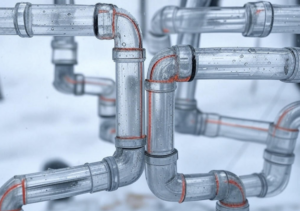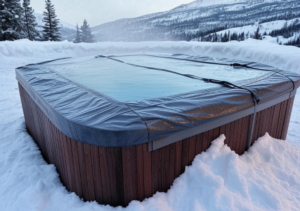Comparative Analysis
Below is a table that compares different winterizing methods. This table shows key steps, benefits, and limitations.
| Method | Key Steps | Benefits | Limitations |
|---|---|---|---|
| Complete Drain & Blow Out | Drain water, vacuum pipes | Removes most water | May leave hidden pockets |
| Drain + Antifreeze | Drain, add non-toxic antifreeze | Extra freeze protection | Incorrect use may harm components |
| Continuous Operation | Keep water running at low heat | Prevents freezing naturally | High energy cost; not for all climates |
Summary Table with Color-Coding
Below is a color-coded table that shows the overall risk of leaks for each method:
| Method | Risk of Leaks | Cost | Ease of Use |
|---|---|---|---|
| Complete Drain & Blow Out | Low | Low | Moderate |
| Drain + Antifreeze | Medium | Moderate | Moderate |
| Continuous Operation | High | High | Easy |
Performance Factors
The risk of leaks after winterizing depends on many factors. You must consider each variable to know what to expect.
Key Variables
- Water Removal Efficiency: The better you drain and blow out the pipes, the less water remains.
- Seal and Material Condition: Old or worn seals may leak regardless of winterizing.
- Climate Severity: Colder climates need more protection.
- Execution Quality: Human error during winterizing can leave hidden water.
Diagram of Key Factors
Below is a simple HTML diagram that shows how these factors interact:
Factors Influencing Leak Risk
- Water Removal
- Draining
- Blowing Out Lines
- Seal Condition
- Material Aging
- Pre-existing Damage
- Climate
- Temperature Fluctuations
- Extreme Cold
- Execution
- Human Error
- Tool Quality
Each of these factors plays a role in how well winterizing can protect your hot tub. Even if you do everything right, old seals or severe weather might still cause problems.

Implementation Guide
Follow these step-by-step instructions to winterize your hot tub properly. Make sure you have all the tools and follow each step carefully.
Step-by-Step Winterization Process
-
Power Off and Disconnect:
- Turn off the power at the circuit breaker.
- Unplug the hot tub to avoid accidental start-ups.
-
Drain the Water:
- Open the drain plug and let all the water exit.
- Use a submersible pump if needed.
- Warning: Ensure the water is completely drained to avoid hidden pockets.
-
Blow Out the Plumbing Lines:
- Use a wet/dry vacuum or air compressor.
- Blow air through all jets and pipes.
- Check that no water is left in low spots.
-
Clean and Inspect:
- Remove and clean filters.
- Wipe down the shell and components.
- Inspect seals and gaskets for any signs of wear.
-
Optional: Add Non-Toxic Antifreeze:
- If you live in an area with very harsh winters, add the correct type of antifreeze to the lines.
- Follow the manufacturer’s guidelines closely.
- Caution: Do not use automotive antifreeze.
-
Secure the Cover:
- Clean and dry the cover.
- Make sure it fits tightly.
- Use straps or a tarp for extra security if needed.
-
Final Check:
- Walk around the hot tub.
- Look for any spots that may have been missed.
- Note any pre-existing damage to fix later.
Tools and Supplies Needed
- Wet/dry vacuum or air compressor
- Submersible pump
- Non-toxic antifreeze (if needed)
- Cleaning cloths and filter cleaners
- Replacement seals or gaskets (if any wear is noted)
- Protective gloves and safety glasses
By following these clear steps, you can reduce the risk of freeze damage and leaks. Always refer to your hot tub’s manual for any model-specific instructions.
Expert Tip: Keep a checklist for your winterizing process. This ensures you do not miss any step.
Troubleshooting Common Leaks
Even after proper winterizing, leaks may appear. Here are common problems and how to fix them.
Common Leak Issues
- Hidden Water Pockets: Small pockets can freeze in hard-to-reach spots.
- Pre-Existing Cracks: Damage that was not fixed before winter.
- Worn Seals or Gaskets: Natural aging can lead to leaks.
- Loose Fittings: Connections may come undone over time.
Diagnostic Steps
-
Visual Inspection:
- Look closely at all seams and joints.
- Check for damp spots or water pools around the tub.
-
Listen for Drips:
- Turn off all water flow.
- Listen for any dripping sounds.
-
Use a Leak Detection Dye:
- Add dye to the water.
- Observe if the dye is drawn toward a crack or leak.
Troubleshooting Tips
- For Hidden Water Pockets: Use a mirror and flashlight to see underneath jets and inside pipes.
- For Pre-Existing Cracks: Note the location and contact a professional for repairs.
- For Worn Seals: Replace seals as per the manufacturer’s instructions.
- For Loose Fittings: Tighten all clamps and union fittings.
Below is a simple HTML decision guide:
Following these steps can help you fix minor issues before they turn into major repairs.
Innovation and Extended Applications
Modern technology brings new ideas to hot tub care. Here are some innovations and creative approaches:
Emerging Trends
- Smart Monitoring Systems: New sensors can track water levels, temperature, and detect leaks in real time.
- Advanced Materials: New, tougher materials for seals and piping can resist freeze damage better.
- Automated Winterization: Some systems now have automatic drain and blow-out features.
Extended Applications
- Year-Round Use: In mild climates, you can keep your hot tub running on low heat. This method prevents freezing and lets you enjoy the tub in winter.
- Hybrid Systems: Combining continuous operation with periodic winterizing can offer extra protection.
- Environmental Adaptation: Smart covers and enclosures help control temperature and reduce energy use.
Expert Insights
Many experts suggest blending old methods with new technology. Using sensors and smart controls can alert you to leaks before they cause major damage. This innovation helps you take action quickly and saves on repair costs.
Expert Tip: Keep an eye on new product releases and technological upgrades. They can provide extra security and peace of mind.
Long-term Considerations
Looking ahead, proper winter care is not just about the cold season. It is a part of overall hot tub maintenance.
Sustainability and Maintenance
- Regular Inspections: Check your hot tub at least once a month.
- Timely Repairs: Fix minor leaks or worn parts quickly.
- Upkeep Costs: Invest in quality parts to avoid repeated repairs.
Longevity Estimates
A well-maintained hot tub can last many years. With regular winterizing and maintenance, you reduce the risk of costly repairs and extend its life.
Cost-Benefit Analysis
While winterizing requires time and effort, it saves money by preventing major damage. Think of it as a small investment in the long-term health of your hot tub.
Expert FAQ Section
Q1: Does winterizing completely stop leaks?
No. It stops freeze-related leaks but cannot fix old damage or worn parts.
Q2: What if I find water pockets after draining?
Re-check with a wet/dry vacuum and inspect hidden spots. Small amounts of water can freeze and cause leaks.
Q3: Can I use automotive antifreeze?
No. Use only non-toxic, hot tub-approved antifreeze.
Q4: How often should I inspect my hot tub for leaks?
At least once a month and after winterizing.
Q5: What is the most common cause of leaks?
Worn seals and incomplete water removal.
Q6: How much does it cost to winterize a hot tub?
It is low to moderate. The cost is much lower than major repair expenses.
Q7: Is continuous operation a good alternative?
It can work in mild climates, but it may be costly in energy and not suitable for very cold areas.
Conclusion
Winterizing your hot tub is a smart way to protect it from freeze damage. It lowers the risk of cracks and leaks by removing water that can freeze and expand. However, no method is foolproof. Pre-existing damage and material wear still pose risks. Regular inspections and maintenance are essential.
Remember, winterizing is just one part of your hot tub care plan. Use smart monitoring and inspect seals often. Taking action now saves you money and hassle later. Protect your investment with care and attention every season.
Your next step is to set up a routine check for your hot tub. Follow the steps in our guide and refer to our troubleshooting tips if you notice any issues. Stay proactive and enjoy your hot tub worry-free!
Additional Resources
- Swim University: Tips on winterizing hot tubs.
- Jersey Hot Tub Repair: Expert repair and maintenance advice.
- The Spruce: General home maintenance for hot tubs.
- Leslie’s Pool Supplies: Comprehensive maintenance guides.
- Outdoor Care Guide: Tips for outdoor spa care.
Technical Glossary
Below is a glossary of technical terms used in this guide:
- Antifreeze: A non-toxic liquid that prevents water from freezing.
- Blow Out: The process of using air to remove water from pipes.
- Gasket: A rubber seal that prevents leaks at joints.
- Insulation: Material used to reduce heat loss.
- Plumbing Lines: Tubing that carries water through the hot tub.
- Residual Water: Small amounts of water that remain after draining.
- Seal: A component that prevents water from escaping.
- Thermal Blankets: Covers that reduce heat loss.
- Vacuum Breaker: A device that prevents water backflow.
- Winterization: The process of preparing a hot tub for cold weather.
By following the guidance in this post, you can ensure your hot tub stays safe through the winter. Stay proactive, use the recommended tools, and enjoy your hot tub year-round without worry.
Feel free to ask for more details or share your feedback for further improvements!

